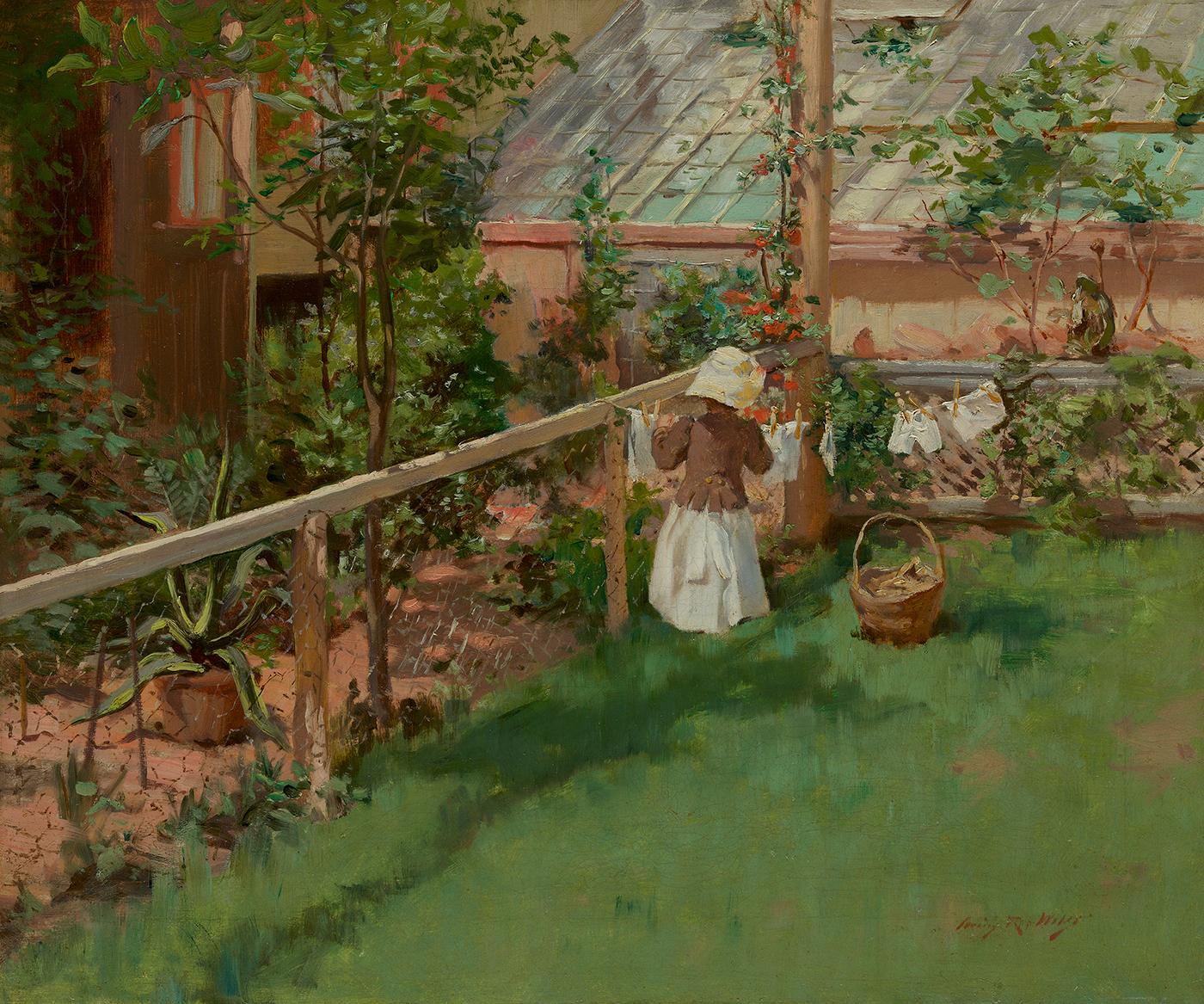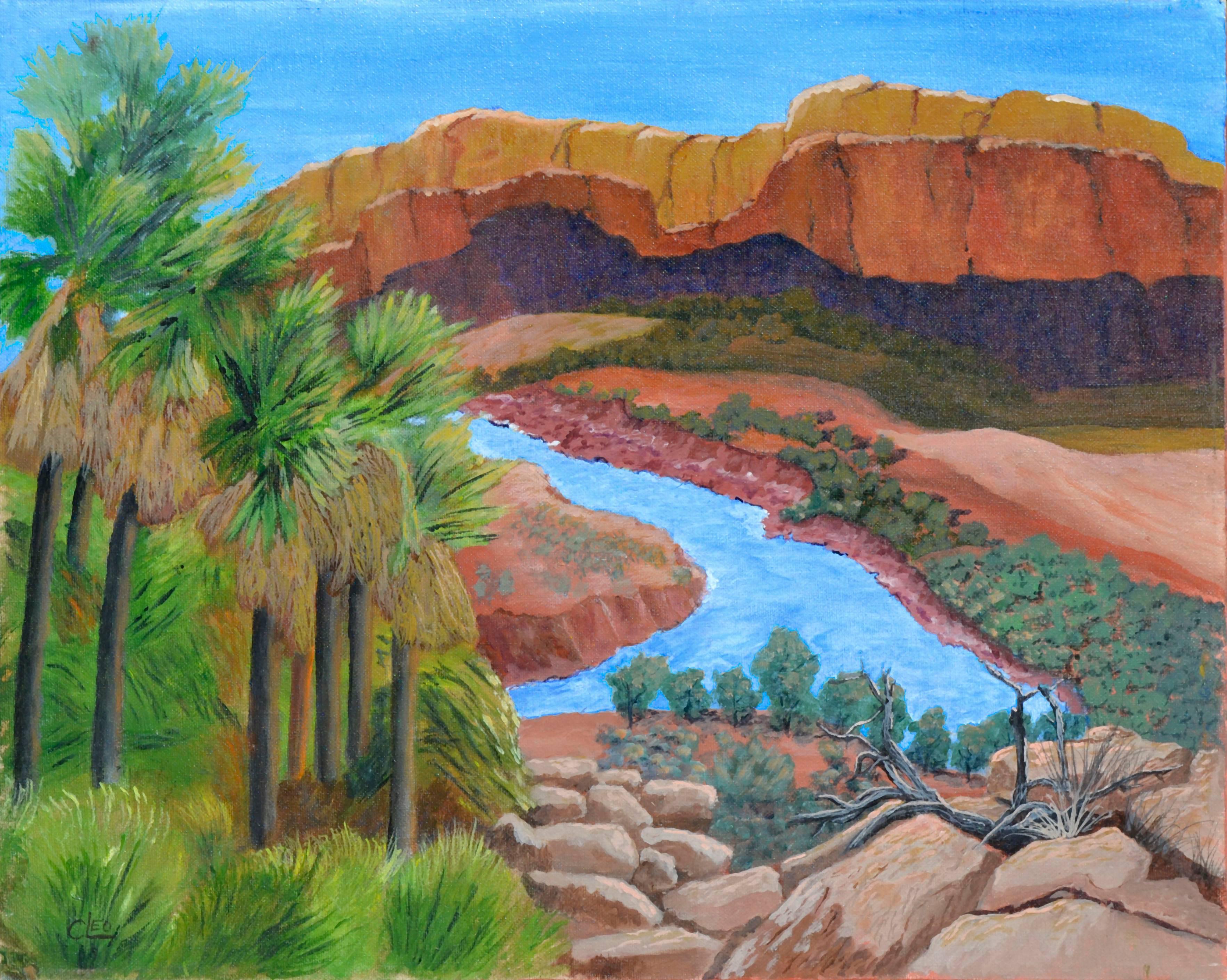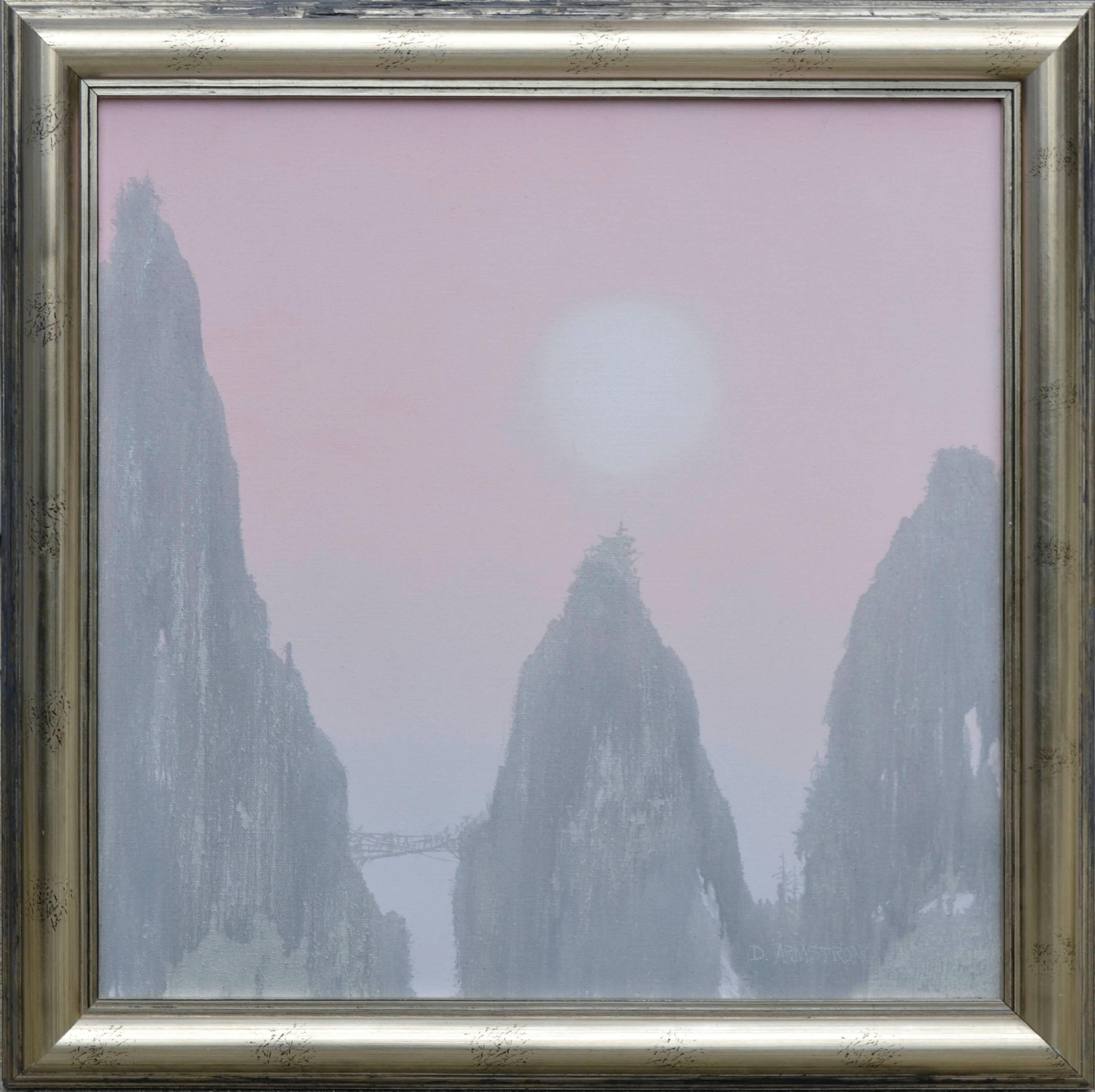Items Similar to "Welldiggers from Titusville"
Want more images or videos?
Request additional images or videos from the seller
1 of 6
Mary Elizabeth Price"Welldiggers from Titusville"c. 1928
c. 1928
About the Item
Jim’s of Lambertville is proud to offer this artwork.
Signed lower right. Complemented by a hand carved and gilt frame.
Illustrated in "New Hope for American Art" by James Alterman, and "Blue Chips" published by Jim's of Lambertville.
M. Elizabeth Price (1877 - 1965)
Mary Elizabeth Price was born in West Virginia and raised on a farm in Solebury, Pennsylvania, on the outskirts of New Hope. She studied at the Pennsylvania School of Industrial Arts and the Pennsylvania Academy of the Fine Arts under Hugh Breckenridge. Additionally, she studied in New Hope with William Lathrop. Following her art studies, Price went to New York. While there, she conducted the “Baby Art School”, a children’s school for painting, in collaboration with Gertrude Vanderbilt Whitney, from 1917 to 1919.
Her home and studio since the mid-1920s, which she named “Pumpkin Seed” cottage, was situated along the canal and towpath in New Hope. When asked where the name came from, Price replied, “When I first saw the original cottage it was painted such a vivid yellow that I instinctively thought of a pumpkin; it was so small that I named it Pumpkin Seed”.
Coming from a rich artistic background, her one brother was F. Newlin Price, a well-known author, art critic, and owner of Ferargil Galleries in New York City, and her other brother was R. Moore Price, the renowned local frame-maker. Artist Rae Sloan Bredin was married to Alice Price, M. Elizabeth Price’s sister.
Although she painted a variety of subjects, including beautiful impressionist landscapes, Price is best known for her paintings of flowers on backgrounds of gold leaf. She would use a sharp tool to draw her designs on a ground of gilded gesso and then add her richly blended colors with delicate charm. The result would be a breathtaking array of floral radiance. The brilliance of the gold background was varied by her method of using sixteen different tones of gold leaf.
She exhibited with “The Philadelphia Ten” from 1921 until 1945, and was one of the founders of the Phillips Mill Art Association. Price went on to show with many galleries in New York. She had solo exhibitions at Grand Central, Anderson, and the Fifty-fifth Street galleries. She was involved in exhibitions in Palm Beach in Florida, Rio de Janeiro, and Buenos Aires. She also exhibited at the Whitney Museum of American Art, the Carnegie Institute, the Corcoran Gallery of Art, the National Academy of Design, the National Association of Women Painters and Sculptors, and the Pennsylvania Academy of the Fine Arts.
Her works are hanging in the permanent collections of Swarthmore, Smith, and Dickenson colleges, as well as many other museums and institutions. Along with Fern Coppedge, M. Elizabeth Price is considered one of the most important women associated with the Pennsylvania Impressionists. She remained in New Hope until her death in 1965 at the age of eighty-seven.
Sources:
- “New Hope for American Art” by James Alterman
- Lambertville Record, May 22, 1930
- New York Sun, March 6, 1930
- Creator:Mary Elizabeth Price (1877-1965, American)
- Creation Year:c. 1928
- Dimensions:Height: 40 in (101.6 cm)Width: 34 in (86.36 cm)Depth: 3 in (7.62 cm)
- More Editions & Sizes:Frame Size 39.5" x 33.5" x 2.5"Price: $74,375
- Medium:
- Movement & Style:
- Period:
- Condition:
- Gallery Location:Lambertville, NJ
- Reference Number:
About the Seller
5.0
Vetted Seller
These experienced sellers undergo a comprehensive evaluation by our team of in-house experts.
Established in 1997
1stDibs seller since 2014
36 sales on 1stDibs
Typical response time: 6 hours
- ShippingRetrieving quote...Ships From: Lambertville, NJ
- Return PolicyThis item cannot be returned.
More From This SellerView All
- "The Canal"By Edward Willis RedfieldLocated in Lambertville, NJJim’s of Lambertville is proud to offer this artwork. Signed lower left. Complemented by a hand carved and gilt frame. Illustrated in "Edward Redfield: Just Values and Fine Seeing" by Constance Kimmerle and the Pennsylvania Academy of the Fine Arts's Exhibition of Paintings by Edward Redfield (April 17 to May 16, 1909) brochure Edward Willis Redfield (1869 - 1965) Edward W. Redfield was born in Bridgeville, Delaware, moving to Philadelphia as a young child. Determined to be an artist from an early age, he studied at the Spring Garden Institute and the Franklin Institute before entering the Pennsylvania Academy from 1887 to 1889, where he studied under Thomas Anshutz, James Kelly, and Thomas Hovenden. Along with his friend and fellow artist, Robert Henri, he traveled abroad in 1889 and studied at the Academie Julian in Paris under William Bouguereau and Tony Robert-Fleury. While in France, Redfield met Elise Deligant, the daughter of an innkeeper, and married in London in 1893. Upon his return to the United States, Redfield and his wife settled in Glenside, Pennsylvania. He remained there until 1898, at which time he moved his family to Center Bridge, a town several miles north of New Hope along the Delaware River. Redfield painted prolifically in the 1890s but it was not until the beginning of the twentieth century that he would develop the bold impressionist style that defined his career. As Redfield’s international reputation spread, many young artists gravitated to New Hope as he was a great inspiration and an iconic role model. Edward Redfield remained in Center Bridge throughout his long life, fathering his six children there. Around 1905 and 1906, Redfield’s style was coming into its own, employing thick vigorous brush strokes tightly woven and layered with a multitude of colors. These large plein-air canvases define the essence of Pennsylvania Impressionism. By 1907, Redfield had perfected his craft and, from this point forward, was creating some of his finest work. Redfield would once again return to France where he painted a small but important body of work between 1907 and 1908. While there, he received an Honorable Mention from the Paris Salon for one of these canvases. In 1910 he was awarded a Gold Medal at the prestigious Buenos Aires Exposition and at the Panama-Pacific Exposition of 1915 in San Francisco, an entire gallery was dedicated for twenty-one of his paintings. Since Redfield painted for Exhibition with the intent to win medals, his best effort often went into his larger paintings. Although he also painted many fine smaller pictures, virtually all of his works were of major award-winning canvas sizes of 38x50 or 50x56 inches. If one were to assign a period of Redfield’s work that was representative of his “best period”, it would have to be from 1907 to 1925. Although he was capable of creating masterpieces though the late 1940s, his style fully matured by 1907 and most work from then through the early twenties was of consistently high quality. In the later 1920s and through the 1930s and 1940s, he was like most other great artists, creating some paintings that were superb examples and others that were of more ordinary quality. Redfield earned an international reputation at a young age, known for accurately recording nature with his canvases and painting virtually all of his work outdoors; Redfield was one of a rare breed. He was regarded as the pioneer of impressionist winter landscape painting in America, having few if any equals. Redfield spent summers in Maine, first at Boothbay Harbor and beginning in the 1920s, on Monhegan Island. There he painted colorful marine and coastal scenes as well as the island’s landscape and fishing shacks. He remained active painting and making Windsor style furniture...Category
Early 1900s American Impressionist Landscape Paintings
MaterialsCanvas, Oil
- "Winter Sunlight"By Walter Emerson BaumLocated in Lambertville, NJJim’s of Lambertville Fine Art Gallery is proud to present this piece by Walter Emerson Baum (1884 - 1956). Born in Sellersville, Pennsylvania, Walter Baum was one of the only membe...Category
1930s American Impressionist Landscape Paintings
MaterialsCanvas, Oil
- "Fields in Jersey"By Daniel GarberLocated in Lambertville, NJJim’s of Lambertville Fine Art Gallery is proud to present this piece by Daniel Garber (1880 - 1958). One of the two most important and, so far, the most valuable of the New Hope Sc...Category
Early 1900s American Impressionist Landscape Paintings
MaterialsCanvas, Oil
- "Christmas Time, Sellersville"By Walter Emerson BaumLocated in Lambertville, NJJim’s of Lambertville Fine Art Gallery is proud to present this piece by Walter Emerson Baum (1884 - 1956). Born in Sellersville, Pennsylvania, Walter Baum was one of the only membe...Category
1930s American Impressionist Landscape Paintings
MaterialsCanvas, Oil
- "End of the Day, Gloucester Harbor"By John Fulton FolinsbeeLocated in Lambertville, NJJim's of Lambertville Fine Art Gallery is proud to present this piece by John Fulton Folinsbee (1892 - 1972). One of the finest painters to embark upon the New Hope Art Colony, John...Category
1910s American Impressionist Landscape Paintings
MaterialsCanvas, Oil
- "In Port"By Edward Willis RedfieldLocated in Lambertville, NJJim’s of Lambertville is proud to offer this artwork by: Edward Willis Redfield (1869 - 1965) Edward W. Redfield was born in Bridgeville, Delaware, moving to Philadelphia as a young child. Determined to be an artist from an early age, he studied at the Spring Garden Institute and the Franklin Institute before entering the Pennsylvania Academy from 1887 to 1889, where he studied under Thomas Anshutz, James Kelly, and Thomas Hovenden. Along with his friend and fellow artist, Robert Henri, he traveled abroad in 1889 and studied at the Academie Julian in Paris under William Bouguereau and Tony Robert-Fleury. While in France, Redfield met Elise Deligant, the daughter of an innkeeper, and married in London in 1893. Upon his return to the United States, Redfield and his wife settled in Glenside, Pennsylvania. He remained there until 1898, at which time he moved his family to Center Bridge, a town several miles north of New Hope along the Delaware River. Redfield painted prolifically in the 1890s but it was not until the beginning of the twentieth century that he would develop the bold impressionist style that defined his career. As Redfield’s international reputation spread, many young artists gravitated to New Hope as he was a great inspiration and an iconic role model. Edward Redfield remained in Center Bridge throughout his long life, fathering his six children there. Around 1905 and 1906, Redfield’s style was coming into its own, employing thick vigorous brush strokes tightly woven and layered with a multitude of colors. These large plein-air canvases define the essence of Pennsylvania Impressionism. By 1907, Redfield had perfected his craft and, from this point forward, was creating some of his finest work. Redfield would once again return to France where he painted a small but important body of work between 1907 and 1908. While there, he received an Honorable Mention from the Paris Salon for one of these canvases. In 1910 he was awarded a Gold Medal at the prestigious Buenos Aires Exposition and at the Panama-Pacific Exposition of 1915 in San Francisco, an entire gallery was dedicated for twenty-one of his paintings. Since Redfield painted for Exhibition with the intent to win medals, his best effort often went into his larger paintings. Although he also painted many fine smaller pictures, virtually all of his works were of major award-winning canvas sizes of 38x50 or 50x56 inches. If one were to assign a period of Redfield’s work that was representative of his “best period”, it would have to be from 1907 to 1925. Although he was capable of creating masterpieces though the late 1940s, his style fully matured by 1907 and most work from then through the early twenties was of consistently high quality. In the later 1920s and through the 1930s and 1940s, he was like most other great artists, creating some paintings that were superb examples and others that were of more ordinary quality. Redfield earned an international reputation at a young age, known for accurately recording nature with his canvases and painting virtually all of his work outdoors; Redfield was one of a rare breed. He was regarded as the pioneer of impressionist winter landscape painting in America, having few if any equals. Redfield spent summers in Maine, first at Boothbay Harbor and beginning in the 1920s, on Monhegan Island. There he painted colorful marine and coastal scenes as well as the island’s landscape and fishing shacks. He remained active painting and making Windsor style furniture...Category
Early 1900s American Impressionist Landscape Paintings
MaterialsCanvas, Oil
You May Also Like
- At the ClotheslineBy Irving Ramsey WilesLocated in New York, NYSigned lower right: Irving R. WilesCategory
Late 19th Century American Impressionist Landscape Paintings
MaterialsCanvas, Oil
- Salmon FishingBy John WhorfLocated in Milford, NHA fine impressionist sporting painting with salmon fisherman in a canoe by American artist John Whorf (1903-1959). Whorf was born in Winthrop, Massachusetts and by the age of sixteen...Category
Mid-20th Century American Impressionist Landscape Paintings
MaterialsOil, Canvas
- Canyon and River - Desert LandscapeLocated in Soquel, CAA beautiful vintage oil painting of a canyon and river. Signed "C. Leo" in the lower left. Oil paint on canvas. Unframed. Image, 16"H x 20"W.Category
1970s American Impressionist Landscape Paintings
MaterialsCanvas, Oil
- Nocturnal Garden Landscape -- West Side CottageBy Kristy SimmonsLocated in Soquel, CAA nocturnal landscape of a cottage shrouded in foliage by Kristy Simmons (American, 20th century). Signed, stretcher bar, on verso. Unframed. Image, 19.38"H x 23.88"W. Painted during...Category
1990s American Impressionist Landscape Paintings
MaterialsCanvas, Oil
- "China Rocks" LandscapeBy Duane Albert ArmstrongLocated in Soquel, CASerene atmospheric styled landscape scene of peaks in China with soft sunrise in the background by Duane Albert Armstrong (b. 1938), 1983. Signed and dated lower right and on verso. ...Category
1980s American Impressionist Landscape Paintings
MaterialsCanvas, Oil
- Pescadero, California Coastal LandscapeBy Weston RoseLocated in Soquel, CAVibrant coastal landscape of Pescadero, California by San Francisco artist Weston Rose (American, 20th century). Presented in a wooden frame. Signed "Weston Rose" lower right. Image,...Category
1970s American Impressionist Landscape Paintings
MaterialsCanvas, Oil
Recently Viewed
View AllMore Ways To Browse
Offers From
Price Of Gold
Price Results
Pennsylvania Impressionist
Gilded Gesso
Elizabeth And James
American Gilded Age
Florida Oranges
William Price
Pumpkin Paintings
Elizabeth Street
Philadelphia Ten
Florida Original Landscape Paintings
Elizabeth Street Gallery
Framed Ferns
William And Mary Small
1920s Beach Painting
Sister Mary




